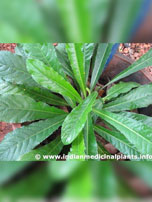Hastipadi

Botanical Name : Elephantopus scaber Linn.
Family : Compositae; Asteraceae.
Introduction : This plant useful in dysuria , fever and cough
Names in different Indian languages :
English : Prickly leaved elephant’s foot
Hindi : Gobhi
Kannada : Hakkarike
Malayalam : Anachuvati,anayatiyan
Sanskrit : Hastipadi
Tamil : Yaanaichhuvadi
Telugu : Hastikaraka
Synonyms :
Mayura-shikhaa, Gojihvaa.
Morphology :
Perennial herb, short roots, grows on ground
Leaves – obovate-oblong, rosette, serrated
Flower – purple
Fruit – achenes
Distribution & Habitat : All over India
Chemical constituents :
Germacranolide dilactones, Hydroxylated germacanolides, molephantin andmolephantinin,
Properties :
RASA-tikta
GUNA-guru
VIRYA-sitha
VIPAKA-madhura
Karma : chasusyam, vrishyam, visha haram, hridya,astringent, cardiac tonic, diuretic, mucilaginous, emmolient , anti cancerous
Indication : Dysuria, Diarrhoea, Dysentery
Part used : Whole plant
Dosage :
1-2 gm
Internal uses:
Urinary system:
Diuretic, useful in removing urinary calculi
Reproductive system:
Increase sperm mobility
Therapeutic Uses :
1. Roots—given to patients with heart and liver affections; topically in rheumatism.
2. Root and leaf— used in dysuria and other urethral complaints.